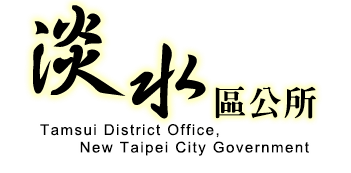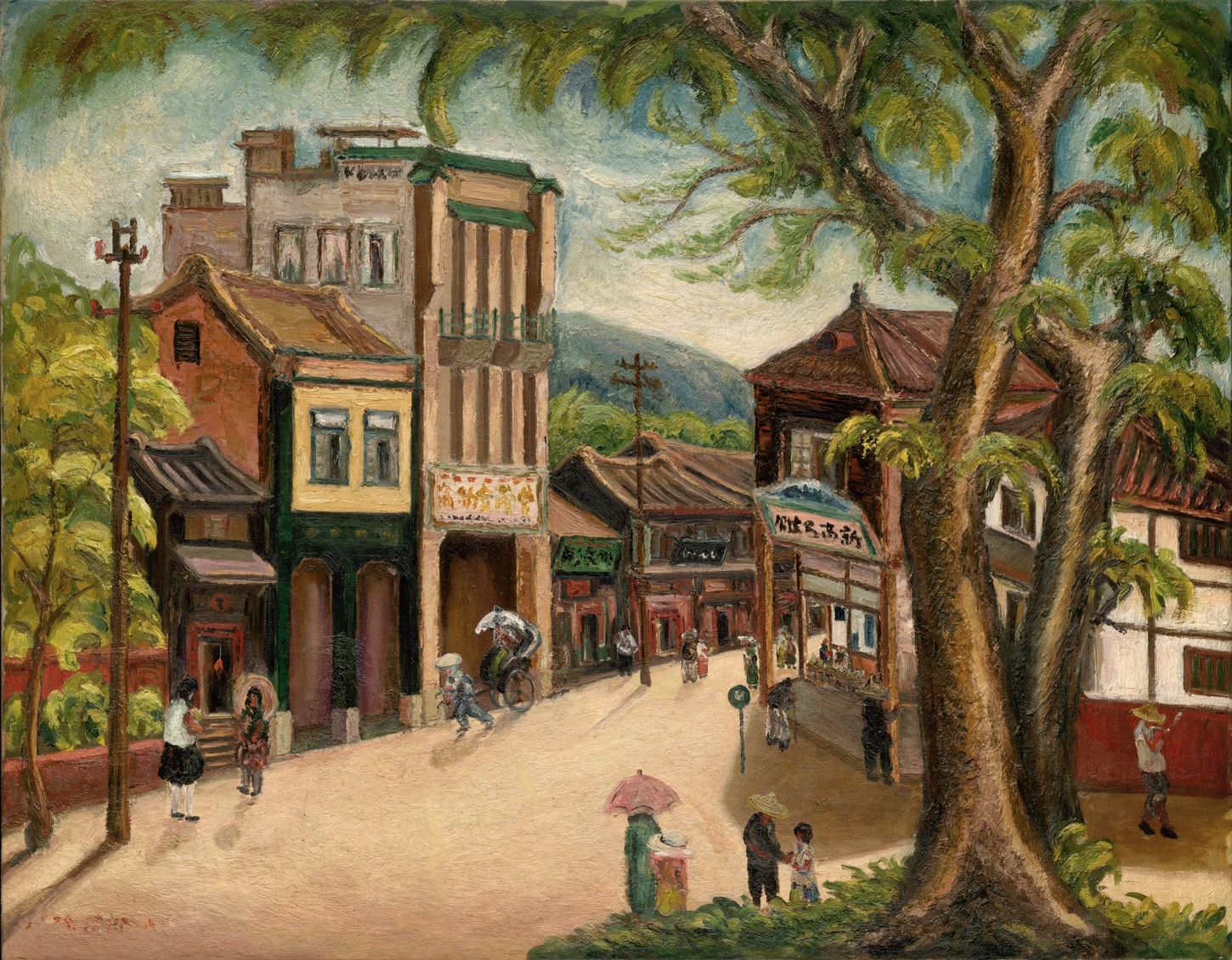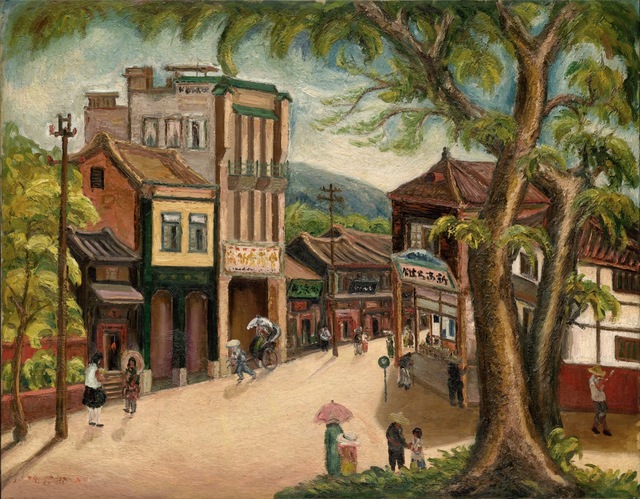畫作名稱
嘉義街景,1934,畫布油彩,91×116.5cm,私人收藏
Chiayi Street Scene, 1934, oil on canvas, 91×116cm, private collection
嘉義の町風景 1934年 キャンバス、油彩 91×116.5cm 個人藏
畫作解析
新式樓房矗立在市街當中,與鄰近的木頭房子、傳統店屋形成有趣的對比。建築物的周圍,陽光徐徐降落,在地面上鋪成大片的暖黃。沐浴在溫熱的光線裡,畫中的一切景物也映現出和煦可愛的顏色。近景一株大樹伸展成蓬幕,彷彿要為街上的人群提供遮蔭。閉上眼睛,試著走進陳澄波的畫境裡,或許,你也能觸摸到屬於這片土地的溫度。
The modern buildings standing in the midst of the city streets are an interesting contrast to the wooden houses and traditional storefronts nearby. The sunlight descends slowly around the building, covering the ground with a large stretch of golden brown. Bathed in the glow of the warm light, everything in the painting also reflects the gentle and lovely colors. A big tree in the foreground stretches out into a canopy, as if to provide shade for the people on the street. Close your eyes and try to walk into Chen Cheng-po’s painting, perhaps you can also touch the warmth of this land.
市街地に立ち並ぶ新しい建物が、周辺の木造家屋や伝統的な店舗と興味深い対比をなしている。建物の周辺に日差しがゆっくりと降り注ぎ、地面が暖かな黄色に染まっている。その日差しを浴びて、絵画の中に描かれた全ての景物が温もりある愛らしい色となっている。また近景の大樹が枝を広げ、路上の人たちに木陰を提供しているかのようだ。目を閉じて陳澄波の絵画の世界を歩いてみれば、この土地の温度に触れることができるかもしれない
新高寫真館、New Height Photo Studio、新高写真館
1927年,來到嘉義創業的攝影師方慶綿買下了這間位於街角的照相館,並沿用「新高寫真館」的舊名。方慶綿以山岳攝影聞名,足跡遍及玉山、阿里山、八通關等地,其作品為早期臺灣山岳的自然與人文景象留下珍貴的歷史紀錄。
In 1927, photographer Fang Ching-mian, who came to Chiayi to set up his own business, bought this corner photo studio and adopted the old name of “New Height Photo Studio”. Fang Ching-mian is well known for his mountain photography, and his travels have taken him to places such as Mt. Jade, Alishan and Batongguan. His works have left a precious historical record of the natural and cultural scenes of early Taiwanese mountains.
1927年、嘉義に創業した写真家の方慶綿氏は、街角にある写真館を購入し、元の「新高写真館」という店名をそのまま引き継いだ。方慶綿氏は玉山や阿里山、八通関山などを踏破した山岳写真家として知られ、彼の作品によって、当時の台湾山岳地帯の自然や文化が記録されている。
「左側通行」立牌、Left-side Traffic、「左側通行」の立て札
左側通行是日本政府導入臺灣的現代化交通規則。透過街上的立牌、巡查的道路指揮、學校教育的宣導等各種方式,總督府在民間積極推行此一政策,但成效有限。戰後,臺灣順應中華民國政府的法令,又改為右側通行。
Left-side access is a modern traffic rule introduced to Taiwan by the Japanese government. The Governor’s Office has been actively implementing this policy in the community through various means such as erecting signs in the streets, dispatching road patrols, and promoting educational advocacy in schools, but the results have been limited. After the war, Taiwan complied with the law of the Chinese National Government and changed to the right-side traffic.
「左側通行」は日本政府が台湾にもたらした近代的な交通ルールである。総督府は路上に立て札の設置や交通整理をする巡査の配置、学校教育による指導など様々な手法によって、この交通ルールが民間に根付くよう積極的に推進していた。しかし、その方法になかなか成果が上がらなく終戦後、中華民国政府の法令によって右側通行に変更された。
永利商店、Yong Li Store、永利商店
兩層樓建築的綠色拱門上方,四個立體字的招牌寫著「永利商店」,這是一間專門販售各種金屬材料與機械工具的商行。有空的話,不妨到嘉義市區的興中街與中正路口尋訪陳澄波的畫中場景,這棟房子是今日唯一存在的景物。
Above the green archway of the two-story building, a sign with four three-dimensional characters reads “Yong Li Store,” a shop specializing in the sale of all kinds of metal materials and machine tools. If you can spare the time, why not visit the scenes in Chen Cheng-po’s painting at the intersection of Xingzhong Street and Zhongzheng Road in downtown Chiayi? This house is the only structure that still exists today.
2階建ての建物の入口に緑色のアーチがあり、その上に立体的な4文字で「永利商店」と書かれている看板がある。この店は各種金属素材や機械工具を販売する店であり、陳澄波の絵に描かれた景物の中で、唯一現存する建物である。嘉義に立ち寄った際には、興中街と中正路の十字路付近にある永利商店をぜひ訪れてみてほしい。
豐茂金物商、Feng Mao Hardware Store、豊茂金物商
偌大一塊招牌寫著「豐茂金物商」,這間由嘉義聞人羅茂松家族所經營的企業,在1930年代不斷擴張規模,並於高雄設立支店。除了經營鋼鐵建材與各類金屬的買賣,該公司還在北社尾成立工廠,製作石綿煙囪與雞舍鐵網等產品。
There is a big billboard that reads “Feng Mao Hardware Store”. Run by the famous Luo Mao-song family in Chiayi, the company expanded in the 1930s and set up a branch in Kaohsiung. In addition to trading in steel and iron construction materials and metals, the company also set up a factory in Beishewei to produce products such as asbestos chimneys and chicken wire mesh.
ひと際大きな看板に「豊茂金物商」という文字が書かれている。この建物は嘉義の名士、羅茂松氏とその一族が経営する企業の店舗であり、1930年代に事業規模を拡げ、高雄にも支店を出した。鉄鋼建材、各種金属の売買や、北社尾に建設された工場で、石綿を使った煙突や鶏舎の金網などを製造した。
嘉義市的新地標、The New Landmark of Chiayi、嘉義市の新しいランドマーク
三層樓的鋼筋水泥建築落成於1934年,這是豐茂商行的事務所,也是當年嘉義前所未見的市街建築。陳澄波的道路風景畫,時常注意現代文明所帶來的景觀改造成果。這棟造型奇特的房子,或許就是驅使他創作這幅畫的主要原因。
This three-storey reinforced concrete building, completed in 1934, was the office of Feng Mau Hardware Store and was first of its kind in Chiayi. Chen Cheng-po’s street landscapes always pay attention to the results of the landscape transformation brought by modern civilization. This one-of-a-kind house is probably the main reason behind his creation of this painting.
この3階建て鉄筋コンクリートの建物は、1934年に落成した豊茂商店の事務所であり、当時の嘉義では、かつてないほどの都会的な建築物であった。陳澄波は、道の風景画を描く際に、いつも現代文明のもたらす景観の変化に関心を示しているようであった。そのため、この斬新なデザインの建物も、陳澄波が作品を描く契機になっていたのだろう。
素描、Pencil Sketches、デッサン
就目前所見,陳澄波針對這幅畫裡的景物,至少製作了三件鉛筆速寫。比較這些作品,我們可以發現他曾經試圖移動視點,使用垂直畫幅,或取消右側的大樹。不變的是,他始終注意安排背景的山巒,以及前景人物的親情互動。
As far as we can see, Chen Cheng-po has made at least three pencil sketches of the scenes in this painting. By comparing these works, we can see that he has tried to move the point of view, use a vertical frame, or eliminate the tree on the right. What has not changed is that he remains attentive to the mountains in the background, and to the intimate interactions of the characters in the foreground.
現在、この絵画を描くために、 陳澄波は最低でも3枚の鉛筆スケッチを描いたことがわかっている。これらのスケッチを比較してみると、縦に長い紙を使い、右側の大木を消すなど、視点を移動させようとしていたことがわかる。しかし常に背景にある山々の配置に気を配っていること、そして前景の人物たちの親しげな様子は変わっていない。
亭仔腳(tîng-á-kha)、Pedestrian Corridors、亭仔腳(tîng-á-kha)
騎樓是流行於中國南方與東南亞地區的建築型制,在高溫多雨的氣候環境裡,街屋前的走廊可以為行人提供遮蔽。日治時期嘉義市區的現代化建設過程中,「亭仔腳」的設置也被政府納入法令,繼而成為熱鬧市街裡的常見景觀。
Recessed sidewalks, or tîng-á-kha in local Taiwanese dialect, are a popular architectural style in southern China and Southeast Asia. Corridors in front of the houses can provide shelter for pedestrians in high-temperature and rainy weather conditions. In the course of the modernization of Chiayi city during the period of Japanese rule, the installation of “recessed sidewalks” was also included in the government’s regulations and became a common sight in the bustling streets of the city.
「騎楼」は中国南部や東南アジアでよく見られる建築装置であり、高温多雨の地域では、日よけ、雨よけの役割を担っている。日本統治時代に嘉義市内で推進された近代化政策の一環として、「亭仔腳」の設置が政府の法令に盛り込まれた。それ以降、騎楼はにぎやかな市街地でよく見かける景観の一つとなった。
修復倫理、Ethical Restoration、修復における倫理
與其他許多陳澄波的油畫相仿,〈嘉義街景〉也曾接受修復。畫作左下角地面的顏料原已大片掉落,主事的木島隆康教授秉持著藝術修復的倫理原則,補上相似並具有可逆性的顏料,讓修補的痕跡與陳澄波的手筆和諧並存。
Just like many of Chen Cheng-po’s oil paintings, “Chiayi Street Scene” has also been restored. The paint on the ground in the lower left corner of the painting had originally fallen off in large pieces. Professor Takayasu Kijima, who oversees the project, adheres to the ethical principles of artistic restoration by adding similar and reversible paints, allowing the traces of restoration to coexist harmoniously with Chen Cheng-po’s brushstrokes.
『嘉義の町風景』は、陳澄波の多くの油彩画と同じように修復されたことがある作品である。修復を担当した木島隆康教授は、修復倫理の原則に基づき、本来使われていたものに近い可逆性のある油彩絵具で、絵画左下の色が剥落した部分の修復を試みた。そのため修復跡は陳澄波の筆のタッチと違和感なく、しっくりとなじんでいる。



